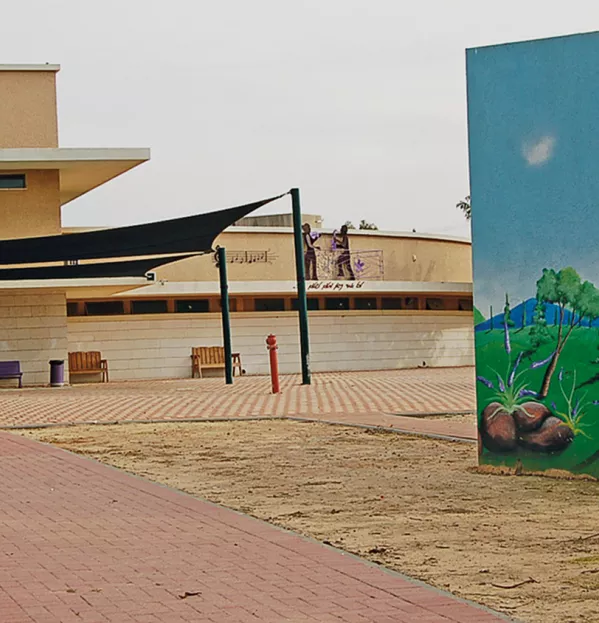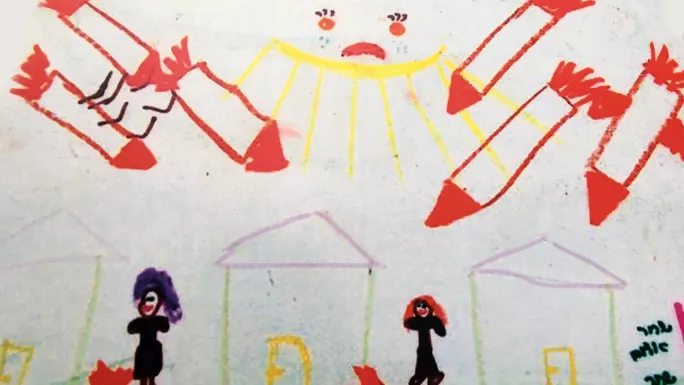‘We’ve got 15 seconds to get pupils to the bomb shelter’

Opposite Kollel Chabad kindergarten is a giant painted caterpillar. Its face is lurid green, its body yellow and orange. There are door-shaped holes in its body, so that children can dart in and out, running through its innards.
And, by each of these entrances is a sign: “bomb shelter”. The caterpillar is made of fortified concrete; it is designed to withstand a direct hit by a Qassam rocket.
The caterpillar and the kindergarten are in Sderot, an Israeli town in the Negev desert. Sderot is less than a mile from the Gazan border: climb a small hillock, and there is a clear view of the tower blocks of Gaza City.
Since 2001, more than 8,400 Qassam rockets have been fired from Gaza into the centre of Sderot. Though attacks peak during times of particular tension, they are ongoing.
Sderot is too close to the Gazan border for Israel’s famed Iron Dome missile defence system to be effective there. As a result, the town’s roads and buildings are pockmarked with shrapnel scars; every home, bus stop and park has its own bomb shelter. And every school in the town is essentially a large, multi-roomed bomb shelter.

Constant danger
“Many children here suffer from anxiety,” says Reception teacher Ayelet Ozeri. “So they have a lot of problems and behaviour issues. Crying without a reason. Hyperactivity. They need attention all the time.”
Chabad infants’ school, where Ms Ozeri works, has a slab of concrete over its roof, as well as steel blocks - brightly painted with the word “welcome” - in front of its entrance. In her classroom, Ms Ozeri has basic spelling words on one wall, and alarm systems on the other.
“In my last job, in another town, the level of study was very high,” she says. “It was very difficult for me to accept that there are different priorities here - that, before children need to know how to count, they need to know how to cope with life.”
Of the 1 billion shekels (£210 million) that the Israeli government has spent on shelters for Sderot, half went on bomb-proofing its schools. All schools now have roofs of fortified concrete, as well as mural-coated bomb shelters scattered around their playgrounds.
“To grow up and to be 16, 17 years old, and to think that this is normal…” Judith Spanglat, a trauma therapist who works with schools in Sderot, leaves the sentence unfinished. “Many, many children have trouble sleeping, or have trouble concentrating. I have seen children who are 14 years old who sleep in their parents’ beds.”
“Of course, you see that sort of thing all over the world, but you don’t see so much of it. If there’s just one or two children in the class who are anxious or hyperactive, the teacher can cope with that. But if most of the children are like that, and their teacher also lives in Sderot, then the children and the teachers are all hyped up.”
A study in 2008, when the attacks spiked, showed that at least 75 per cent of school-aged children in Sderot suffered from post-traumatic stress. Therapists such as Dr Spanglat add that the trauma is ongoing: “post-traumatic” suggests an aftermath.

Mushka Sharon (pictured, above) sees this trauma on a daily basis. She is the principal of Kollel Chabad kindergarten, opposite the caterpillar bomb shelter. Over its roof is a one-metre thick slab of concrete, painted in jaunty colours; the windows are made from bullet-proof glass.
Opening the school’s main door, Ms Sharon grimaces: the door, made from metal and reinforced glass, weighs 600kg. “Every morning, parents have to take a deep breath before opening the door,” she says. “It’s good exercise for me, going from classroom to classroom.”
She shuts the door carefully. “Any small noise can immediately start the children crying,” she says. “Even an ice-cream truck - they’ll be scared from that. Aeroplanes overhead. Any small noise.” She pauses. “Of course, when something actually happens in Gaza, the children can hear it all - explosions so loud you can’t know if they’re happening next to you or outside the town.”
Around Sderot are metal masts, which blast out air-raid sirens - known as “colour red” in Hebrew. These warn residents that they have 15 seconds to reach shelter, before the rocket hits. “In my previous school, we just had one secure room,” says Ms Sharon. “Every time the colour red sounded, we had to grab all the children and get into the shelter. Fifteen seconds to run with all the children and babies.”
A study showed at least 75 per cent of school-aged children suffered from post-traumatic stress
Now, she has a series of techniques to help her pupils overcome the fear of noise that is the legacy of the rocket explosions and the shrieking sirens. She begins by asking them to tap their fingers on the desk. Then they move on to tapping pencils, and then banging their chairs against the floor, acclimatising themselves to a succession of louder and louder noises.
Meanwhile, trauma therapists teach children mindfulness and breathing exercises. They also train the teachers to practise these exercises with their pupils.
And children are encouraged to express themselves through drawing and painting: one Sderot child’s drawing shows a sadlooking sun gazing down, as rockets rain on the town.
“Children have grown up in an environment of continual threat,” says Dr Spanglat. “The ramifications of a big military war - things pop up years later.”
Dropping his children off at Kollel Chabad, Osher Pizem taps one of its windows. “It’s like a bunker,” he says. He sighs. “When you go to the shower, when you go to the bathroom, every time, you think, ‘What will I do now, if the terrorists shoot a rocket?’”
Despite this, he has no intention of leaving. “Sure, I’m worried,” he says. “But the solution is not to show weakness to terrorism. The terrorists think if they shoot rockets, they win. But I win, because I live with my children in Sderot, and I’m happy.”
You need a Tes subscription to read this article
Subscribe now to read this article and get other subscriber-only content:
- Unlimited access to all Tes magazine content
- Exclusive subscriber-only stories
- Award-winning email newsletters
Already a subscriber? Log in
You need a subscription to read this article
Subscribe now to read this article and get other subscriber-only content, including:
- Unlimited access to all Tes magazine content
- Exclusive subscriber-only stories
- Award-winning email newsletters